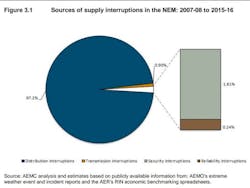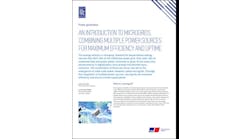The Real Cause of Blackouts in Australia and the Drive for Distributed Energy
RenewEconomy’s Sophie Vorrath explains the true cause of blackouts in Australia and what’s driving consumers to install solar plus storage.
Electricity outages that left tens of thousands of Victorian households without power on Sunday and Monday turned up a few interesting home truths about Australia’s national energy market.
One of those, of course, was that not many people have any sort of grasp on how the NEM (National Electricity Market) works – least of all, it seems, certain members of the federal and state LNP.
But another, much more important truth to come out of it has been that the vast majority of what Australian consumers know as blackouts are caused by local faults on poles and wires, and not by coal plants melting in the heat/wind not blowing/sun not shining.
RenewEconomy was reminded of this fact again this week by Craig Memery, from the not-for-profit Public Interest Advocacy Centre (PIAC), via the below Tweet.
Using the AEMC’s Reliability Frameworks Interim Report, Memery’s chart shows that a whopping 92.7 percent of blackouts are caused by distribution (poles and wires) faults, while just 0.24 percent (around 10 seconds a year, per household) arise from insufficient generation.
This is interesting to note for a couple of reasons. Firstly, because we now know that the cost of building and maintaining our our networks of poles and wires is the single biggest contributor to eye-water consumer power bills that are driving people to solar and battery storage at a record rate.
As it stands, Memery adds, “you could increase (power generation outages) tenfold, and people would not notice,” he said.
“A big concern of mine, and (the PIAC), with all of these reforms directed towards improving reliability, is that if we don’t keep checking back with what the consumer is prepared to pay for, we’ll end up with a gold-plated wholesale market, on top of gold-plated distribution networks,” he told RenewEconomy on Tuesday.
And that has all sorts of other implications, as Gavin Dufty, the manager of policy and research at St Vincent de Paul Society in Victoria points out in the Tweet below.
But of course, no amount of money sunk into poles and wires – and there has already been tens of billions – can guarantee the delivery of power in the face of bushfires, floods, cyclonic winds or equipment failures.
And it brings us to the next home truth uncovered by the weekend’s blackouts: Australian consumers are highly intolerant of losing power, despite having one of the most reliable markets in the world (even if we have paid dearly for it).
Comparatively speaking, Australia keeps its wholesale market to a reliability standard of 99.998 per cent. Most other countries, meanwhile, including the US, have reliability standards that allow for several hours of lost power each year, rather than just the few minutes permitted in Australia.
And as Memery warns, if our obsession with reliability – which is being whipped along nicely by both politicians and mainstream media – is not kept in check, then consumers face paying even more, for little tangible added benefit.
“Even in spite of the worst of the doomsday predictions,” Memery tells RE, “we’re still nowhere near breaching (our) reliability standard.”
This, too, is an interesting fact to note, when you consider the fuss that is being made in certain political and media quarters over the reliability of electricity supply, as Australia’s aging coal-fired power plants are closed down and replaced with decentralized, distributed renewable energy generation.
The point is, if we want to maintain the current high standard of reliability, then Australia will have to shift from its centralized model to a decentralized model, and that means encouraging more rooftop solar, more renewables, and more storage.
As AEMO’s Audrey Zibelman and AGL Energy’s Andy Vesey will both tell anyone who asks, this will mean having local generation – like solar – and battery storage scattered around the grid.
That is starting to happen to a certain extent. The new battery to be opened in a few months next to the Wattle Point wind farm in South Australia will create a sort of mini-grid, when the network is down elsewhere.
That means it can use the local wind farm, and the region’s rooftop solar, to guarantee supplies when access to gas and other generators elsewhere in the state is cut off.
This article originated on RenewEconomy and was reposted with permission. Sophie Vorrath is deputy editor at RenewEconomy.







